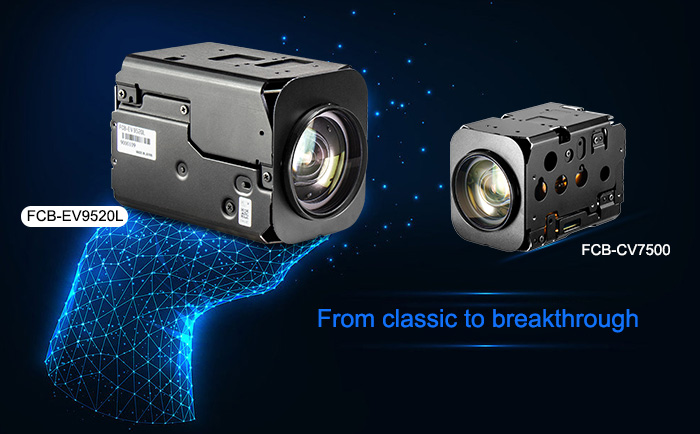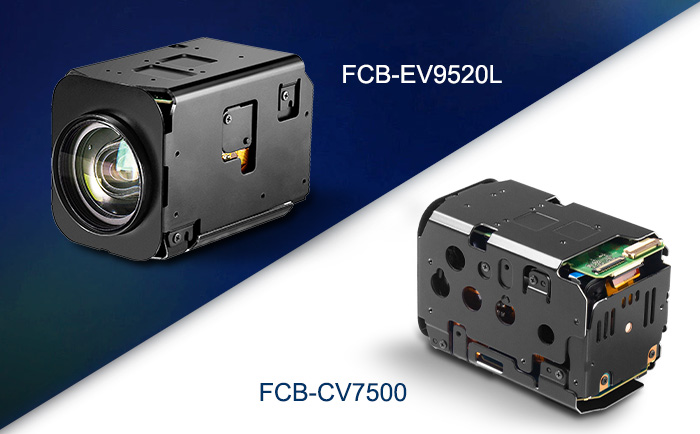SONY FCB-EV7500 not only use 2.38 million effective pixel Exmor CMOS sensor and 30x optical zoom lens, but also support the output of 1080P full HD, 720P HD and SD analog signals, playing an important role in the transition from analog signals to 1080P full HD signals.
FCB-EV9520L, as a new generation of SONY 1080P full HD integrated camera module, compared with SONY FCB-EV7500, what are the common points and breakthroughs?

SONY FCB-EV7500 and FCB-EV9520L
First, common parameters
Fuselage size: The FCB-EV9520L has the same fuselage size as the FCB-EV7500, both 50mm×60mm×89.7mm, which makes the two have high compatibility when installing and replacing.
LVDS output: Both support LVDS output and have the same output pin definition for seamless docking and upgrades.

Common parameters of FCB-EV7500 and FCB-EV9520L
Resolution and frame rate: Both can provide 1920×1080 resolution, support 1080P/60FPS high frame rate output, to meet the needs of high-definition picture quality.
Optical Zoom: Both have 30x optical zoom capability to capture sharp, stable images at different distances.
Second, breakthroughs
Sensor type:
The SONY FCB-EV9520L uses a 1/2.8″ STARVIS2 CMOS sensor, which is a backlit architecture with higher sensitivity and color reproduction capabilities to provide better image quality in low-light environments.
SONY FCB-EV7500 uses 1/2.8″ Exmor CMOS sensor, which belongs to the front lighting structure, although it also has high performance and low noise characteristics, but in terms of sensitivity and low illumination performance, compared with SONY FCB-EV9520L slightly inferior.
Anti-shake function:
The SONY FCB-EV9520L is equipped with super image stabilization, which captures high-precision video even in harsh environments with strong vibration through greatly improved blur suppression and image stabilization, and has S and S+ modes, which users can select according to different levels of shake.
SONY FCB-EV7500 uses electronic anti-shake technology, although it can also provide a certain anti-shake effect, but in the severe shaking environment may not be as good as FCB-EV9520L performance.
Wide dynamic range:
The SONY FCB-EV9520L has a higher wide dynamic range of 130dB, enabling it to more effectively handle scenes with strong light contrast and obtain clear images.
Although the SONY FCB-EV7500 also has a wide dynamic function, the specific dynamic range is not as high as the SONY FCB-EV9520L, that is, in the environment where light and dark coexist, the captured picture is different from the ratio of the SONY FCB-EV9520L.
Other features:
The SONY FCB-EV9520L also supports advanced features such as regional auto focus, regional auto exposure, and regional auto white balance. The combination of these advanced features makes the SONY FCB-EV9520L shine in a number of areas. For example, in areas such as security monitoring, industrial vision, intelligent transportation and video conferencing, more precise image processing can be performed on key areas to obtain a clearer and more accurate picture, providing finer image control and adjustment.
3. Application scenarios

Comparison of application scenarios of SONY FCB-EV7500 and FCB-EV9520L
SONY FCB-EV7500: It is more suitable for some application scenarios with good lighting conditions and low anti-shake requirements, such as video conferencing, medical equipment, industrial testing, etc.
SONY FCB-EV9520L: Due to its excellent low light performance and super image stabilization, it is more suitable for security monitoring, intelligent transportation, shipborne systems, bridge monitoring and drone aerial photography, and other applications requiring high definition and stability.
To sum up, SONY FCB-EV9520L and FCB-EV7500 have their own specifications, and users should choose according to specific application scenarios and requirements.
 Sony FCB camera block
Sony FCB camera block